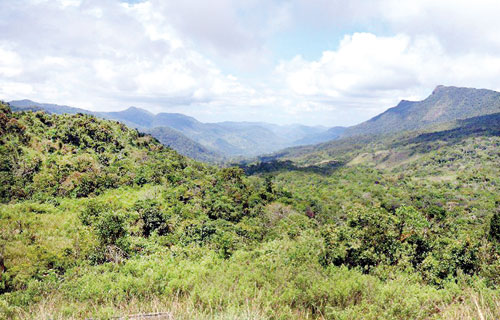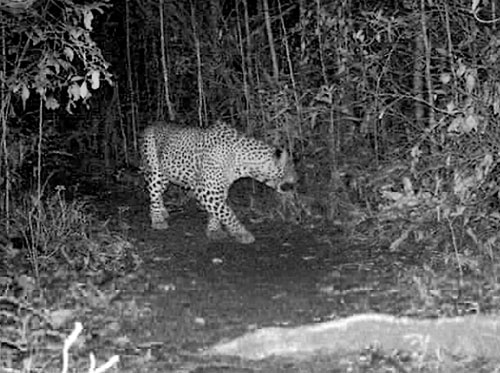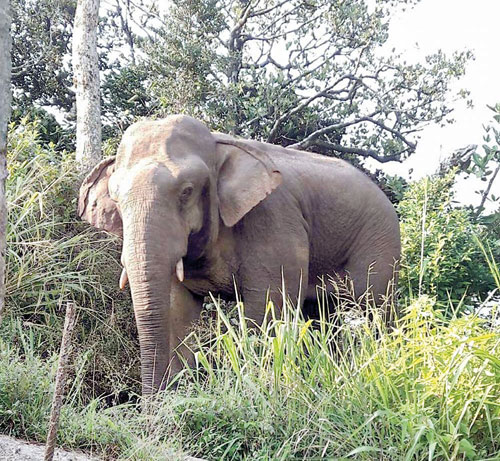News
Protect unique Sinharaja with a strict eco-tourism plan
View(s):Local and foreign visitors roam this rainforest, home of elephant and leopard, without restriction
By Kumudini Hettiarachchi
A stunning image of a majestic elephant emerging from a mist-laden forest fills the screen…………a little while later along the same pathway tread a group of carefree tourists, both local and foreign. These are the ‘Vistas of Eastern Sinharaja’ and the dangers of not monitoring human visitors to this Protected Area that the Galle Wildlife Conservation Society’s Madura De Silva brought to the audience at an important panel discussion on ‘Biodiversity & Sustainable Tourism’ on May 22 at the HNB Auditorium in Colombo.

Spectacular and mysterious Sinharaja -- a World Heritage Site
The event was organised by Biodiversity Sri Lanka (BSL) on International Day for Biological Diversity with four panellists dealing with ‘Vistas of Sinharaja’; ‘Dollars for Deeds’; ‘Challenges in the Yala National Park (NP)’; and ‘Significance of the coasts around us’. The discussion that followed was moderated by BSL Advisor Shiranee Yasaratne. (Last week, we published ‘Challenges in Yala’ and ‘Significance of coasts’.)
Before Mr. De Silva takes up the major issues that need to be addressed at Sinharaja which falls under the mandate of the Forest Department, he waxes eloquent on this World Heritage Site consisting of tropical sub-montane rainforests and pathana grasslands. Eastern Sinharaja is “unique” due to its geography at an elevation range of 575-1,170m and meteorological patterns of an annual rainfall of between 3,600mm and 5,000mm and annual temperatures ranging from 17-27ºC.
Other factors that make it unique are eight species of point endemic amphibians and four species of lizards. It was at the Morningside Forest Reserve that Mr. De Silva himself and his team also came upon a new species of a point endemic plant, Aponogeton kannangarae.

Wet-Zone leopards ‘captured’ by camera traps at Sinharaja in the ongoing research
He elaborates on the Low-land Wet Zone Leopard Project which has as its aim the establishment of a strategic conservation plan for the Big Cats of this area, with the Field Research Centre at Enasalwatta. In this major public-private partnership among the Wildlife Conservation Society of Galle, the Open University of Sri Lanka, the Nations Trust Bank and the Rainforest Ecolodge, Wet Zone leopards are the focus as they are poorly studied, unlike those in the Dry Zone. The studies involve identification of individual leopards by their spots through images from camera-traps, pug-marks and scat analysis. The first-year study results have helped ascertain the leopard distribution in eastern Sinharaja.
Thereafter, Mr. De Silva gives guidelines on how a model for responsible eco-tourism could be established. Urging that there should be an in-depth tour-guide training programme, he says that their knowledge on rainforest ecology and identification of fauna and flora should be improved, while also making them aware of the legal aspects that need to be strictly adhered to under the Fauna and Flora Ordinance when people visit Protected Areas.
“This is while there is a need not only to educate but also make the communities living on the boundaries to participate in the conservation project,” he says, adding that even visitors should be kept in the loop so that they too could provide their expertise and data for the conservation project.

A Sinharaja tusker in all its majesty
| ‘Dollars for Deeds’ conservation programme of Tangalle’s Anantara It is Anantara Hotel’s Dilan Bandara from Tangalle who focuses on how they have just embarked on a ‘Dollars for Deeds’ programme for conservation, with the strong support of the International Union for Conservation of Nature (IUCN). The vision of the programme is for the hotel to match the contribution of guests, $ for $ (dollar for dollar), for conservation. To have solid evidence to show the guests, the hotel has already begun the programme, before seeking guest contributions. Before detailing the programme, Mr. Bandara describes the ‘modern’ traveller as being highly individual, tech-savvy and open-minded. On a mission to live life to the full, he/she seeks the exceptional, thriving in the new, at ease riding horseback on a dusty trail in the Andes as in a spa in the Maldives or enjoying the serendipity of metropolitan encounters in a downtown neighbourhood. “We create journeys of inspiring, surprising moments and enjoyment — elevating all senses and connecting with the environment and culture of each one of our locations. Anantara is a luxury hospitality brand for modern travellers, connecting them to genuine places, people and stories,” he says, stressing that corporate social responsibility (CSR) is a way of life for them. With sustainability development being an integral part of Anantara’s organizational strategy, they are committed to developing ‘The Dollars for Deeds’ programme in Tangalle, he says, laying down their objectives and proposed activities. Conduct in-situ conservation of marine turtles, thus contributing to conserving globally-threatened species. The proposed activities include identifyingthe relevant stakeholders such as hotel staff, government line agencies, and local communities who will be involved in monitoring of turtle-nesting and conducting a workshop on the guidelines that should be followed for recording turtle-nesting.  Tiny turtles waddle towards the sea on the beach of Tangalle Raise awareness on marine turtle conservation and enhancement of field-level capacity of the Department of Wildlife Conservation (DWC) to conduct in-situ conservation of marine turtles. The proposed activities include keeping exhibits — such as eight display panels and models of the five turtle species visiting Sri Lankan shores — at the information corner of the proposed DWC Beat Office in Rekawa and establishing a ‘Media Wall’ at a selected location of the resort to display information/short documentaries on turtles, a section/panel with project related activities to introduce the ‘Dollars for Deeds’ programme. Enhance the representation of native species of flora within the property and establish a typical coastal habitat for native coastal species. Build the capacity of the resort for conservation and sustainability (hotel staff, local communities and guests). The proposed activities include aFund to be utilised for conservation of globally-threatened marine turtles, Asian elephants etc. | |

